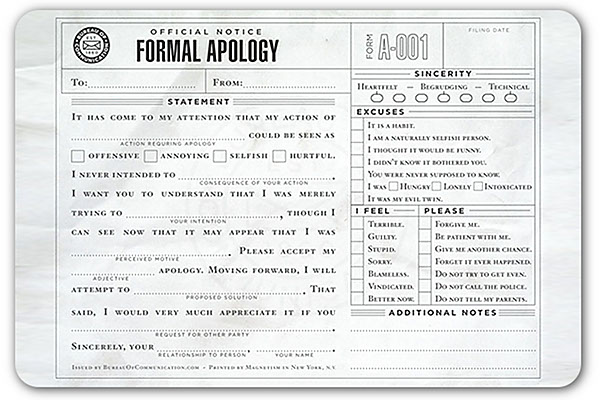


‘I’m Sorry’: How You Say It Says a Lot About Your Organization
[By Thom Fladung, Hennes Communications]
In 2010, The New York Times Magazine wrote about the explosion of public apologies – or, as the Times put it, the mea culpas, sometimes with very little mea.
Back then, it was Gen. Stanley McChrystal, saying I’m sorry for talking ill of President Barack Obama in Rolling Stone and BP chief executive Tony Hayward, apologizing (kind of) for his company’s oil well polluting the Gulf of Mexico, and many more.
The Times piece was headlined “Why Is It So Hard To Apologize Well?”
Five years later, and we have Volkswagen apologizing and GM apologizing and Hillary Clinton apologizing – all to varying degrees of acceptance.
And still, as Elton John sang, “sorry seems to be the hardest word.”
Riding to the rescue is a Harvard Business Review piece, in the September 2015 issue, that we think lays out one of the smartest, most cogent guides we’ve seen for organizational apologies. Smart enough that we’d like to use it as a jumping-off point to explore different facets of saying “I’m sorry” amid a crisis, starting with this piece.
As the Harvard Business Review says: “In this article, we present an apology formula, drawn from our work and research in management and psychology, that provides a diagnostic and practical guidance on the who, what, where, when, and how of an effective apology. The bottom line for serious transgressions: Senior leaders must immediately express candor, remorse, and a commitment to change in a high-profile setting – and make it sincere.” And near its conclusion, the article suggests: “We recommend role-playing and ‘apology rehearsals.’”
That one brought us up a bit short. How do you practice “candor” or “remorse”? If you take this very calculating, step-by-step approach to saying “I’m sorry” will it still feel real?
Indeed, a commenter on the online version of the story posted this: “For the extreme cases of BP and GM…thinking through ‘core or non-core,’ ‘how the public will react’ and whether apologizing in persons (sic) puts the leader in an ‘uncontrolled environment’ is not what a leader would do. It is what a psychopath does.”
That said, the piece in the Harvard Business Review also makes this crucial point: “An apology enables an executive to express concern and convey the organization’s values…”
It strikes us this last part is the crucial point: An organization’s – and an individual’s — values will be most starkly revealed at the most critical, high-pressure times. The purest ore is produced from the hottest furnace, as Charles Caleb Colton wrote.
And the elements of an effective apology are neatly captured in the attributes of successful leaders and organizations.
One piece in Forbes argues those include: honesty, communication, intuition.
Another Forbes list – “10 Traits of Great Business Leaders” – includes “owning your mistakes” among those traits.
And Stephen Covey famously wrote “Seek First to Understand, Then to be Understood,” saying that empathy and “empathic listening…creates an atmosphere of caring, and positive problem solving.”
So, yes, practice apologizing. Think hard – ahead of time — about when your organization should do it and how you would do it. As the Harvard Business Review points out, many factors go into effective apologies. But if you’re coming from a place where empathy, honesty, accountability and transparency aren’t among the highest values, all the practice in the world won’t help.